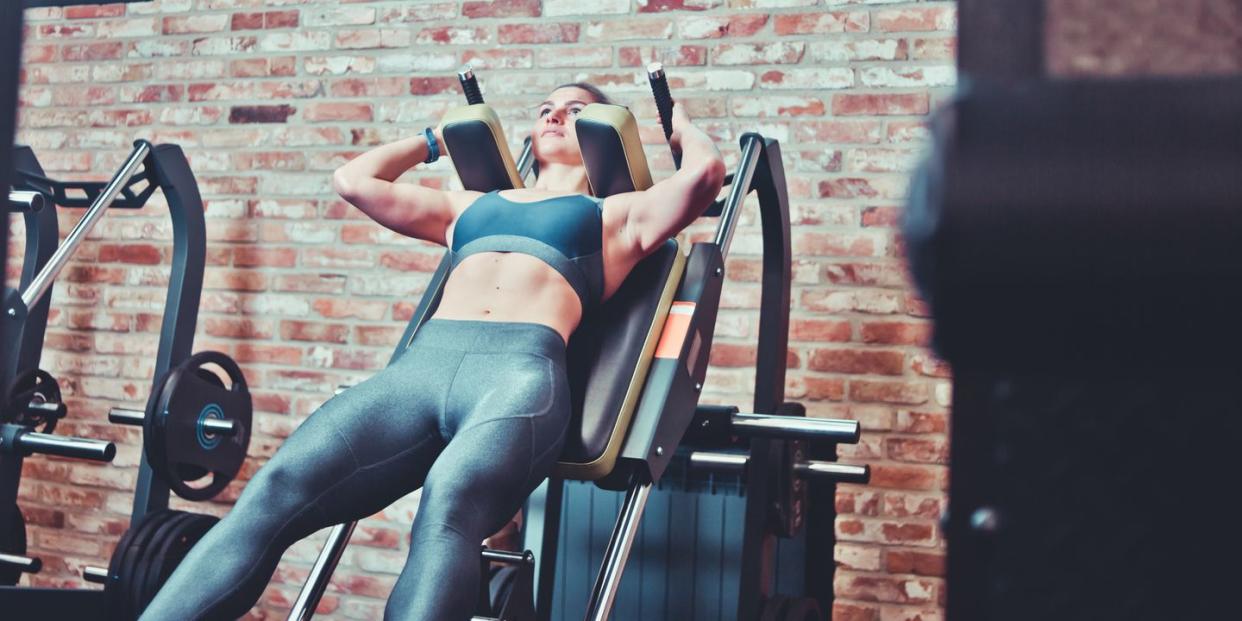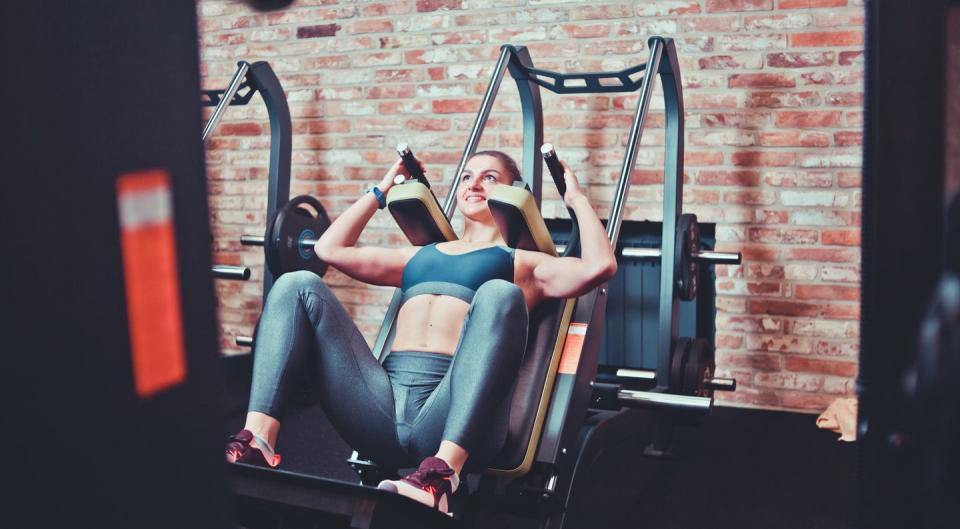Trainers Say This Squat Variation Is Amazing For Your Quads

Squats are a rockstar lower-body move. You can do squats pretty much anywhere, like while you're brushing your teeth or with a fully-loaded squat rack in the gym.
You probably already are doing squats often because squats offer so many benefits, strengthening your lower body and core in one swoop, building muscle, and revving your metabolism. But you might not be doing hack squats, one of the many squat variations...yet.
Meet the experts: Kehinde Anjorin, CFSC, NCSF, is the creator of The Power Method. Roxie Jones, CPT, is a trainer at Alo Moves. Kristina Earnest, CPT, has over 9 years of fitness teaching experience with indoor cycling and more.
In particular, hack squats can help increase power and speed for jumps, according to recent research. The hack squat is done with a machine that has back support. "It’s very similar to the leg press, but done at an upright 45-degree angle,” says Roxie Jones, CPT, a trainer at Alo Moves.
Whether you want to build the strongest legs possible or just need to mix up your usual gym routine (hey, been there!), the hack squat machine can help you make workout magic happen.
Here, fitness pros break down what to know about this weight room machine, how it can boost your squat strength, and how to use it for big-time results.
What is a hack squat, exactly?
The hack squat machine features an angled platform that you stand on and a moveable backrest with shoulder pads and handles that slide up and down a track as you squat. You'll add weight to racks attached to the back and shoulder pads and press through your feet, working your glutes, hamstrings, calves, and hip flexors to push the weights along the track as you squat and stand. On most hack squat machines, your feet are positioned at a 45-degree angle, so your body leans back slightly.
How are hack squats different from regular squats?
While regular squats often involve holding and balancing some sort of weight (like dumbbells or a barbell), the hack squat machine takes stability out of the equation, says trainer Kehinde Anjorin, CFSC, NCSF, creator of The Power Method. Since you're pushing the weight up and down the machine's fixed track while resting your back and shoulders on the pads, you'll primarily work your lower body and don't need as much core engagement or upper-body stability as you'd need during a free-standing squat.
That said, hack squats are most similar to barbell front squats because the load is distributed more to the front of your body, meaning they put extra emphasis on your quads, Anjorin says.
“This is a really isolating machine for the quads, allowing someone to go very heavy and build quad strength," Jones says. "It’s also a great alternative for someone who wants to train their quads or glutes, but may have a neck or back injury that prevents them from using free weights.”
The benefits of hack squats are legit.
Though the core and upper body required in standard squats are two of their biggest benefits, hack squats also come with perks related to the more fixed, stable movement involved.
They're great for beginners. "Since a hack squat is performed using a machine, it requires very minimal coaching cues or technique,” says Anjorin. For that reason, hack squats are great for beginners looking to kickstart building strength. The machine allows very little room for error, so squat newbies can focus on training their legs without worrying about maintaining their core and overall stability, she explains.
The move allows you to lift heavier. This more-stable movement pattern also means you can go heavier with the move. “By removing the instability of a barbell or dumbbells, you can lift more [weight]," Kory Flores, CPT, a trainer at boxing studio Rumble says. This is especially true if limited grip strength is holding you back from working with heavier weights.
Hack squats are great prep for barbell squats. “It’s also an opportunity to test out a heavy weight before transitioning to a barbell squat,” Flores adds. You can thank a combo of the built-in upper body support and the slightly-reclined angle of the hack squat machine for making this possible.
You *really* fire up your lower body. Hack squats can help isolate your lower body, allowing you to build strength there faster, according to Kishon Pierce, CPT, a trainer at Blink Fitness. “As opposed to barbell squats, the hack squat works the entire lower body including glutes, hamstrings, quads and calves," Pierce says. "When you use the hack squat machine, it carries your stabilization, so you are focused on the lower body only.”
They help you improve your overall squat form. Hack squats can also help you improve your traditional back squat form, while adding weight, according to Kristina Earnest, CPT. "It provides more stability than a barbell squat while providing similar benefits," she says. "This is because the angled machine has you in a standing position yet safely supported." Your lower body is still powering the movement.
How To Do A Hack Squat With Perfect Form

Sold on the hack squat's benefits—but not quite sure what to do when you actually step up to the machine? Allow Anjorin to break it down for you:
Set up the machine with the appropriate weight, loading each side equally. (Start lighter and build from there!)
Step into the machine by placing back on the backrest and shoulders up against the shoulder pads.
Position feet on the sled platform so they're about hip-width distance (or desired stance) apart and grab handles located near shoulder pads.
Push through feet to fully extend hips and knees, then release safety pins. This is your starting position.
Slowly lower into a squat (until knees hit 90 degrees), then push through heels to press back to starting position.
Repeat for the desired amount of reps and sets.
Work it in: You can incorporate hack squats into your workout just as you'd mix in any other squat variation. That said, if your number-one priority is to use hack squats to build muscle, Anjorin recommends doing three sets of 10 to 12 reps during a workout.
Common Hack Squat Mistakes To Avoid
While hack squats are generally very safe, there are a few mistakes you should watch out for. Below are the most common hack squat mistakes, as well as how to fix your form to avoid them.
Improper foot placement. “Placing your feet too close together actually puts unwanted stress on your knees, which could lead to injuries later down the line,” says Pierce. Instead, he recommends positioning feet shoulder-width apart, so that you engage the glutes and hamstrings. Don't place your feet too high up on the foot plate, either, according to Earnest. "Proper positioning is critical when working under tension."
Going too heavy too quickly. “One common mistake that I find when it comes to hack squats is that people may go heavy too quickly and add too much weight,” says Jones. If the weight is too heavy, you won't be able to use the full range of motion and it's not as effective. It’s best to start light, making sure you have your form right before adding more weight, says Jones. You want to get your knees to 90 degrees, says Earnest. "Just because the machine helps support the weight added onto it, doesn’t mean we should come out of the gate too hot," adds Earnest.
Not engaging your abs. “Even though you isolate your lower body during a hack squat, you still need to make sure to engage your core,” says Jones. “Doing the exercise with an anterior pelvic tilt may end up hurting the lower back. Think about connecting the ribs and hips together to keep the abs engaged and to prevent any possible injury.”
Hack Squat Variations To Try
Just like a traditional squat, there are a few variations of the hack squat as well. You can find a way to use the machine that works for you. (Trust!)
Reverse Hack Squat: "Get into the machine facing the pads. Aim to put your chest against the back pad and your shoulders underneath the shoulder pads. Keeping the same shoulder-width foot placement, lower down until your thighs are parallel, then push through your heels to return to start. This position works your glutes more. In this position, your hips aren't locked into a specific motion path, since your shoulders and feet are the only points of contact with the machine.
Narrow Hack Squat: Bring feet closer together on the platform to start. "You should still push through your heels as you come to standing," says Earnest. "This movement places even more emphasis on the quads and requires more stability." You can also start with a wider stance. “A narrow stance will be more quad-focused, and a wider stance will allow more glute engagement,” says Jones. (Note: If you have knee issues keep feet shoulder-width apart or wider, in order to prevent injury.)
Is there anyone who shouldn't do hack squats?
Though hack squats are beginner-friendly, they're not for everyone. “If you have any lower back pain or knee pain, I would not recommend hack squats, as they put a higher amount of strain on your joints,” says Flores.
Bottom line: Hack squats are performed on a machine, and they involve less core and upper-body work than traditional squats and place more emphasis on your lower body, especially your quads.
You Might Also Like

